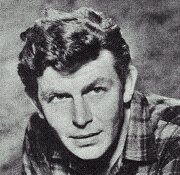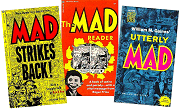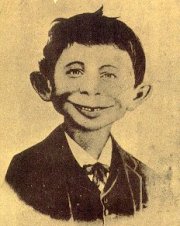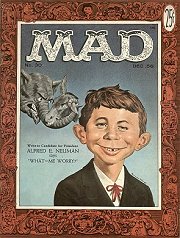 ad Magazine, as we know it today, began as a comic book in October 1952. It was part of a popular line of comics called E.C. comics published by William M. Gaines. ad Magazine, as we know it today, began as a comic book in October 1952. It was part of a popular line of comics called E.C. comics published by William M. Gaines.  Most of these Entertaining Comics were of the horror, science fiction, war and crime variety with titles like Vault of Horror, Weird Science, Frontline Combat and Crime Suspenstories. In Gaines' pool of talented artists and writers, Al Feldstein edited Most of these Entertaining Comics were of the horror, science fiction, war and crime variety with titles like Vault of Horror, Weird Science, Frontline Combat and Crime Suspenstories. In Gaines' pool of talented artists and writers, Al Feldstein edited 
the horror and science fiction titles while Harvey Kurtzman 
took charge of the war comics. In the beginning, Gaines was the reluctant but capable motivator of these mad men. He was thrown into the publishing position after the tragic death in a boating accident of his father Max C. Gaines. Max is credited with originating the idea of assembling newspaper comic strips into the comic book form with 1934's Famous Funnies. 
As the hunger for original stories became obvious, Max had a hand in developing the super-hero genre with DC comics as co-publisher with Harry Donenfeld. It could be argued that Max was more concerned with the moral content of his books than with the amount of money they were pulling in. Max's ties to DC ended when he sold his shares, parted company and put that conscience into his new E.C. business.
Before they were Entertaining, Max's E.C. line was Educational Comics and were far tamer with titles like Picture Stories from the Bible and Animal Fables. Just as Max's E.C. was feeling the effects of playing it safe he died in the boat crash. William, on his way to becoming a school teacher, satisfied his mother's wishes by stepping in for his father, but didn't know the first thing about comic book publishing.
He learned fast and with the help of editors Feldstein and Kurtzman and all the artists and writers like Jack Davis, Will Elder, Wally Wood and Johnny Craig, he turned E.C. into a creative powerhouse. Feldstein was a workhorse, churning out seven horror and science fiction titles to Kurtzman's two war titles, but Kurtzman was appreciated for the attention to detail he gave to his stories, attention which required a considerable amount of research and time. |
 dmirable as that was, Gaines paid based on output, so when Kurtzman approached Gaines to talk about getting closer to Feldstein on the pay scale, Gaines suggested he develop a humor comic. Mad was born. dmirable as that was, Gaines paid based on output, so when Kurtzman approached Gaines to talk about getting closer to Feldstein on the pay scale, Gaines suggested he develop a humor comic. Mad was born. 
For two years Kurtzman parodied the comics and other media in the 23 Mad comics that followed while Feldstein continued his horror and science fiction mayhem. That mayhem caught the eyes of those who thought the horror and crime comics were a corrupting influence on America's youth. The early fifties was a time of conservative paranoia over Communist and subversive threats. 
Senator Joseph McCarthy was the embodiment of the irrational fear that America was being over run by evil doers within its own population. Witch-hunts and trials and public demonizing of those suspected of being part of this wave cast a shadow over the entire entertainment industry. E.C. was not immune. 
Gaines was forced to defend his livelihood, but the compelling testimony of "experts" like Frederic Wertham whose book, Seduction of the Innocent, painted a bleak portrait of the harmful effects of Gaines' graphic comics on children. It was too much for the public to ignore. When directly questioned at a hearing about the suitability of a certain severed-head cover  for children, Gaines' attempts to reason with the subcommittee member didn't help his cause and E.C. comic sales dropped drastically. A comics code was established and required publishers to submit works for rating before they could hit the stands. for children, Gaines' attempts to reason with the subcommittee member didn't help his cause and E.C. comic sales dropped drastically. A comics code was established and required publishers to submit works for rating before they could hit the stands.
E.C. was virtually dead except for some comparably boring "New Trend" titles like M.D. and Valor. Artists and writers were laid off and Feldstein was let go as the horror and crime books faded away. Slightly earlier, Kurtzman was offered a magazine editing position with a rival publication. To keep Harvey on board Gaines decided to turn Mad into a magazine with the July 1955 issue number 24. This also helped Mad to escape the new comics code.  |
 oing some of his finest work, Kurtzman loved the idea of working in the new, bigger format but wanted more creative control which Gaines was not willing to give up.Gaines fired Kurtzman and scrambled to get Feldstein back with the September 1956 issue number 29. Under Feldstein's editorship, Mad hired famous personalities to contribute articles to the magazine. oing some of his finest work, Kurtzman loved the idea of working in the new, bigger format but wanted more creative control which Gaines was not willing to give up.Gaines fired Kurtzman and scrambled to get Feldstein back with the September 1956 issue number 29. Under Feldstein's editorship, Mad hired famous personalities to contribute articles to the magazine. 
This took Mad in a more public direction because it had name recognition going for it. The young Mad was fine tuning its cast of regulars in these early years with the likes of Don Martin, Dave Berg, Jack Davis, Mort Drucker, Frank Jacobs -- the Usual Gang of Idiots, and eventually the guest contributions dwindled. As Mad's popularity grew, Gaines rejected advertiser's wishes to place ads in Mad. He felt his license to make fun of whatever needed to be made fun of would be compromised if it was sponsored.
So the business plan was to sell lots of subscriptions, Mad collectible junk, and collections of previously published Mad articles gathered together in the form of pocketbooks and "Specials." 
A mysterious smiling boy with a missing tooth shows up on a Mad pocket book and on comic issue number 21. He begins to make regular appearances in the cover border artwork of the magazine. His likeness had been seen in one form or another since the late 1800s in political and product print ads but no one is sure who his original creator was. Norman Mingo is hired to paint him officially as Mad's write-in candidate for president in 1956 with issue number 30.
Mad's mascot is officially named Alfred E. Neuman. Mingo's Alfred would come to represent the standard reference for all future artists' depictions. Mingo, himself, would go on to paint 97 covers. And that's as far as I want to go here, which isn't very far at all. Volumes could be written on all the great artists and writers alone, not to mention the stories behind some of the more controversial subjects Mad poked fun at over the years. The biggest changes to Mad in sixty-five plus years have been its change in parent companies (D.C. Comics, Warner), the change in editorial staff from Feldstein to Nick Meglin and John Ficarra in 1985, the death of William Gaines in 1992, the change to a color format along with the accepting of advertising in 2001, and Mad's evolving movement into the digital realm of internet applications. At the end of 2017, MAD left New York to begin operations in Burbank, California.
SUGGESTED READING:
Completely Mad
- by Maria Reidelbach
Collectibly MAD
- by Grant Geissman
Good Days and MAD
- by Dick DeBartolo
The MAD World of
William M. Gaines
- by Frank Jacobs
|